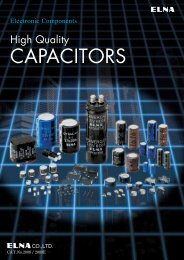Aluminum Electrolytic Capacitors
Aluminum Electrolytic Capacitors
Aluminum Electrolytic Capacitors
Create successful ePaper yourself
Turn your PDF publications into a flip-book with our unique Google optimized e-Paper software.
ALUMINUM ELECTROLYTIC CAPACITORS®Cautions for Using <strong>Aluminum</strong> <strong>Electrolytic</strong> <strong>Capacitors</strong>Please read product specifications before using ELNA products.The following cautions should be observed when using our aluminum electrolytic capacitors to assure their maximumstability and performance. When your application design conditions or operating conditions exceed the limit of theproduct specification, please contact us. If used under conditions beyond the limit of our specifications, it may causedefects such as short circuit, open circuit, leakage, explosion or combustion.Cautions for usage1. DC electrolytic capacitors are polarized.• If used with a wrong polarity, it creates an abnormalcurrent resulting in a short circuit or damage toitself. Use DC bipolar electrolytic capacitors for usewith uncertain or unknown polarity. DC capacitorscannot be used in AC circuits.2. Use within the rated voltage.• If a voltage exceeding the rated voltage is applied,it may cause characteristic deterioration or damagedue to the increased leakage current.• When ripple current is loaded, make sure that thepeak value of the ripple voltage does not exceedthe rated voltage.3. Using for power supply circuit.• While aluminum electrolytic capacitors are operatedelectrolyte liquid inside dries up and E.S.R.(Equivalent Series Resistance) of the capacitorincreases. In case operated longer than rated lifetime, the capacitance much decreases, tangent ofloss angle and E.S.R. much increases. Thereforefor some case the sum of bias direct voltage andthe peak of ripple voltage is over the rated voltageof the capacitor.• For any type of circuit, in case the sum of biasdirect voltage and the peak of ripple voltage is overthe rated voltage of the capacitors or in case theminimum voltage is lower than 0 (zero) volt, thevoltage control for the capacitors shall be provided.4. Do not use in a circuit which requires rapidcharging or discharging.• If used in a circuit requiring rapid charging or discharging,it may cause characteristic deteriorationor damage to itself due to the heat generated insidethe capacitor. In such cases, contact us for ourrapid charging/discharging capacitors.5. Use within the rated ripple current.• If applied ripple current exceeds rated ripple current,the life of the capacitor may be shortened, or in anextreme case it gets destroyed due to its internal heat.Use high-ripple type capacitors for such circuits.6. Changes in characteristics due to operatingtemperature.• The characteristics of an electrolytic capacitor willchange with a change in the temperature. Suchchanges are temporary and the original characteristicswill be restored at the original temperature (ifCAT.No.2010/2011Ethe characteristics are not deteriorated by remainingat a high temperature for a long time). If used at atemperature exceeding the guaranteed temperaturerange, the capacitor may be damaged due to theincreased leakage current. Pay attention to thecapacitor temperature being affected by the ambienttemperature of the unit, the temperature inside theappliance, the heat radiated by another hot componentin the unit and the heat inside the capacitor itself dueto the ripple current.(1)The electrostatic capacitance is normally shownas the value at 20°C-120Hz. It increases as thetemperature raises and decreases as it lowers.(2)The tangent of loss angle (tan) is normallyshown as the value at 20°C-120Hz. It decreasesas the ambient temperature gets high andincreases as it gets low.(3)The leakage current increases as the temperaturegets high and decreases as it gets low.7. Changes in the characteristics due to frequency.• The characteristics of an electrolytic capacitor willchange according to the change in the operatingfrequency.(1)The electrostatic capacity is normally shown asthe value at 20°C-120Hz. It decreases as thefrequency increases.(2)The tangent of loss angle (tan) is normallyshown as the value at 20°C-120Hz. It increasesas the frequency gets high.(3)The impedance is normally shown as the value at100kHz 20°C. It increases as the frequency lowers.8. <strong>Aluminum</strong> electrolytic capacitor life.• The life of an aluminum electrolytic capacitor terminateswhen it fails due to the deterioration in itselectronic characteristics. Temperature and theripple current since they especially affect the life.See chart on page.9. Changes in aluminum electrolytic capacitorsduring storage.• After storage for a long period, whether unused ofmounted on the appliance, the leakage current ofan aluminum electrolytic capacitor will increase.This tendency is more prominent when the ambienttemperature is high. If a capacitor has been storedfor more than 2 years under normal temperature(shorter if high temperature) and it shows increasedleakage current, a treatment by voltage applicationis recommended. Addition of a protective circuit in






